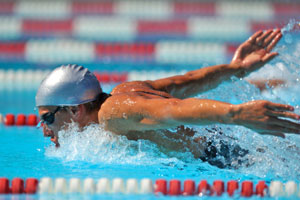Shoulder tendonitis and the term shoulder impingement have likely plagued athletes since the beginning of time. With sport events becoming increasingly competitive and demanding more of our bodies with less rest and recovery time, the result often is pain and reduced ability to move easily and comfortably. These conditions affect young athletes more commonly as training schedules increase and sport-specific exercises become more taxing.

Participation in more than one sport sets an expectation for the body to rapidly shift from one focus of high-demand activity to another. Neither activity may be complimentary.
Consider a swimmer and volleyball player. Both sports require specific overhead motions to excel, but the movements are quite different. Swimming requires a pulling movement. Volleyball requires a striking movement. If the tendon, ligament and muscle structure supporting the shoulder, are not working together properly, poor body mechanics and pain from inflammation will result. The scapula, or shoulder blade, can be thought of as the foundation of your shoulder. If it is not stable, anything added to it will eventually over compensate or fail.
Tendonitis
Tendonitis is a non-specific term used to denote inflammation within the tendon unit where the muscles attach to bone. This can be a painful and concerning issue. It usually responds to rest, anti-inflammatory medications and physical therapy.
Traumatic shoulder injury
Traumatic injury, such as a shoulder joint tear or dislocation, may predispose an athlete to persistent or recurring shoulder tendonitis. Recovery may be long and frustrating. But return to activity too early often results in continued pain and dysfunction. With appropriate treatment shoulder tendonitis can be a reversible condition. Studies have not revealed a definite link between long-standing inflammation and irreversible structural changes (tendonopathy), but it is a commonly accepted theory.
Shoulder impingement
Shoulder impingement is a term commonly used to describe a shoulder rotator cuff irritation on the undersurface of the shoulder blade and nearby ligaments. Medical providers debate whether bone spurs, or the bony scapular anatomy, results in the tendon irritation associated with the rotator cuff.
Shoulder impingement is highly likely to lead to rotator cuff problems later in life, but it rarely is a medical issue for young athletes. It is more common that pain and impingement of the rotator cuff tendons occurs because of subtle hyperlaxity or looseness of the joint, or because of poor shoulder blade position during sport specific motions. For shoulder-involved motions such as pitching, batting, throwing and volleying, and other rotating, overhead motions, proper technique and training can make a difference in preventing shoulder injuries.
Article submitted by Orthopedic Surgeon Todd Schubkegel, M.D., Marshfield Clinic Eau Claire Center.
Share comments or questions on this information email: sports.medicine@marshfieldclinic.org.
